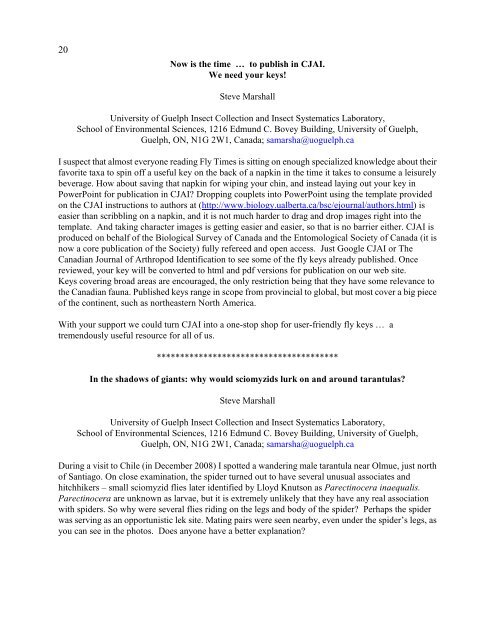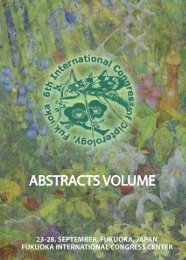Fly Times Issue 48, April 2012 - North American Dipterists Society
Fly Times Issue 48, April 2012 - North American Dipterists Society
Fly Times Issue 48, April 2012 - North American Dipterists Society
You also want an ePaper? Increase the reach of your titles
YUMPU automatically turns print PDFs into web optimized ePapers that Google loves.
20<br />
Now is the time … to publish in CJAI.<br />
We need your keys!<br />
Steve Marshall<br />
University of Guelph Insect Collection and Insect Systematics Laboratory,<br />
School of Environmental Sciences, 1216 Edmund C. Bovey Building, University of Guelph,<br />
Guelph, ON, N1G 2W1, Canada; samarsha@uoguelph.ca<br />
I suspect that almost everyone reading <strong>Fly</strong> <strong>Times</strong> is sitting on enough specialized knowledge about their<br />
favorite taxa to spin off a useful key on the back of a napkin in the time it takes to consume a leisurely<br />
beverage. How about saving that napkin for wiping your chin, and instead laying out your key in<br />
PowerPoint for publication in CJAI Dropping couplets into PowerPoint using the template provided<br />
on the CJAI instructions to authors at (http://www.biology.ualberta.ca/bsc/ejournal/authors.html) is<br />
easier than scribbling on a napkin, and it is not much harder to drag and drop images right into the<br />
template. And taking character images is getting easier and easier, so that is no barrier either. CJAI is<br />
produced on behalf of the Biological Survey of Canada and the Entomological <strong>Society</strong> of Canada (it is<br />
now a core publication of the <strong>Society</strong>) fully refereed and open access. Just Google CJAI or The<br />
Canadian Journal of Arthropod Identification to see some of the fly keys already published. Once<br />
reviewed, your key will be converted to html and pdf versions for publication on our web site.<br />
Keys covering broad areas are encouraged, the only restriction being that they have some relevance to<br />
the Canadian fauna. Published keys range in scope from provincial to global, but most cover a big piece<br />
of the continent, such as northeastern <strong>North</strong> America.<br />
With your support we could turn CJAI into a one-stop shop for user-friendly fly keys … a<br />
tremendously useful resource for all of us.<br />
***************************************<br />
In the shadows of giants: why would sciomyzids lurk on and around tarantulas<br />
Steve Marshall<br />
University of Guelph Insect Collection and Insect Systematics Laboratory,<br />
School of Environmental Sciences, 1216 Edmund C. Bovey Building, University of Guelph,<br />
Guelph, ON, N1G 2W1, Canada; samarsha@uoguelph.ca<br />
During a visit to Chile (in December 2008) I spotted a wandering male tarantula near Olmue, just north<br />
of Santiago. On close examination, the spider turned out to have several unusual associates and<br />
hitchhikers – small sciomyzid flies later identified by Lloyd Knutson as Parectinocera inaequalis.<br />
Parectinocera are unknown as larvae, but it is extremely unlikely that they have any real association<br />
with spiders. So why were several flies riding on the legs and body of the spider Perhaps the spider<br />
was serving as an opportunistic lek site. Mating pairs were seen nearby, even under the spider’s legs, as<br />
you can see in the photos. Does anyone have a better explanation
















